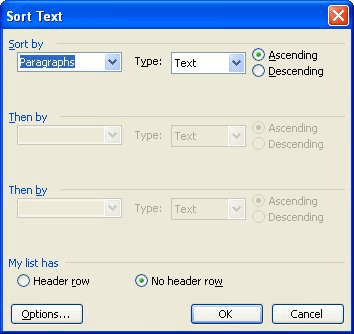Please Note: This article is written for users of the following Microsoft Word versions: 97, 2000, 2002, and 2003. If you are using a later version (Word 2007 or later), this tip may not work for you. For a version of this tip written specifically for later versions of Word, click here: Controlling Sorting Order.
Written by Allen Wyatt (last updated April 6, 2019)
This tip applies to Word 97, 2000, 2002, and 2003
If you have used Word for more than a week, you probably already know how to sort information in your document. You can use sorting to arrange a list in either ascending or descending order. Ascending order for the English language is from 0–9, A–Z; descending order is the reverse. The sorting order for other languages will be different. To specify the sorting order you simply choose the Ascending or Descending radio buttons in the Sort dialog box.
You can also affect sort order by indicating whether Word should pay attention to the case of the text in your selection. If a sort is case sensitive, then items are sorted A-Z and then a-z for ascending sorts. If a sort does not pay attention to case, then uppercase and lowercase letters are treated the same.
To specify whether Word should pay attention to case, follow these steps:

Figure 1. The Sort Text dialog box.

Figure 2. The Sort Options dialog box.
WordTips is your source for cost-effective Microsoft Word training. (Microsoft Word is the most popular word processing software in the world.) This tip (1849) applies to Microsoft Word 97, 2000, 2002, and 2003. You can find a version of this tip for the ribbon interface of Word (Word 2007 and later) here: Controlling Sorting Order.

Learning Made Easy! Quickly teach yourself how to format, publish, and share your content using Word 2021 or Microsoft 365. With Step by Step, you set the pace, building and practicing the skills you need, just when you need them! Check out Microsoft Word Step by Step today!
Word allows you to easily sort the information you store in a document. If you want to sort information as groups of ...
Discover MoreWord is great at sorting simple information in tables and paragraphs. If you have more complex information (such as ...
Discover MoreWord gives you the option to sort selected groups of text. You can do text, date or number sorts on whole paragraphs or ...
Discover MoreFREE SERVICE: Get tips like this every week in WordTips, a free productivity newsletter. Enter your address and click "Subscribe."
2019-07-17 16:43:49
Diann Lazenby
I use 2013. The only way to get the Sort menu to appear (and it's not under paragraph) is to be IN a table! Then, and only then, does it appear under Layout. I don't understand how you can get the Sort menu any other way.
(see Figure 1 below)

Figure 1.
Got a version of Word that uses the menu interface (Word 97, Word 2000, Word 2002, or Word 2003)? This site is for you! If you use a later version of Word, visit our WordTips site focusing on the ribbon interface.
Visit the WordTips channel on YouTube
FREE SERVICE: Get tips like this every week in WordTips, a free productivity newsletter. Enter your address and click "Subscribe."
Copyright © 2025 Sharon Parq Associates, Inc.
Comments